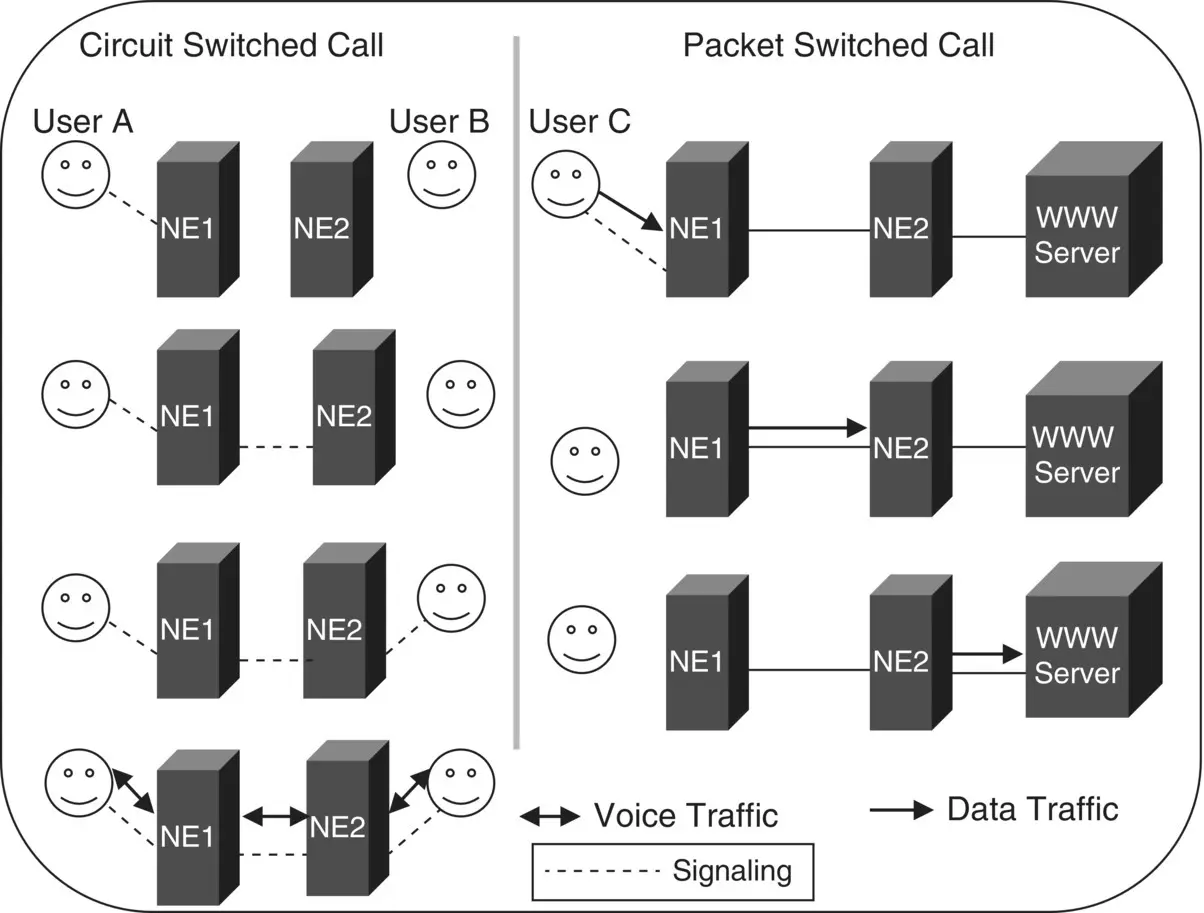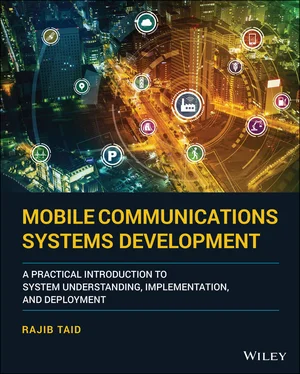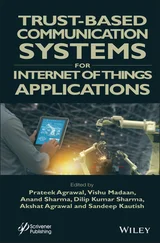1 ...7 8 9 11 12 13 ...41 
Figure 2.4 Overall network architecture and elements of an LTE network.
Source : © 2015. 3GPP ™ TSs and TRs are the property of ARIB, ATIS, CCSA, ETSI, TSDSI, TTA and TTC who jointly own the copyright in them. © 2015, 3GPP.
The LTE system is an all IP‐based network, i.e. all the network elements communicate with the existing IP transport network only. This differentiates the LTE communication network from its predecessors, GSM, GPRS, and UMTS networks, which uses other transport networks, such as ATM and Frame Relay, apart from the IP transport network.
From the comparisons of Figures 2.1– 2.4, it appears that the number of network elements in an LTE/EPS network has reduced. This has led to a smaller number of protocols and interfaces between network elements compared to the GSM and UMTS system. For an overall description of the functions performed by each of the network elements of the respective mobile communications network described above, refer to the TS 23.002 [29].
2.1.5 GSM, UMTS, LTE, and 5G Network Elements: A Comparison
Based on the similar functions performed, one can compare the different network elements of a GSM, UMTS, and LTE network. A side‐by‐side comparison of different network elements of GSM, GPRS, UMTS, and LTE networks is shown in Table 2.1below. The BTS and BSC of a GSM network are known as the NodeB and RNC in the UMTS system. Similarly, the functions performed by a BTS and BSC of a GSM network are performed by the eNodeB only that is found in an LTE network which was shown in Figure 2.4.
2.1.6 Circuit Switched (CS) vs Packet Switched (PS)
At the beginning of Section 2.1, the types, i.e. CS as well as PS, of services being provided by a typical mobile communications network was mentioned. In the case of a CS call , an end‐to‐end dedicated physical circuit establishment is required prior to the starting of voice call service on it. However, no such dedicated physical resources or path is required to be established for a PS call. A refresher illustration showing this basic difference between a CS and PS call is shown in Figure 2.5.
In Figure 2.5illustration, User A wants to start a CS voice conversation (bold solid line) with User B. Prior to that, a dedicated and exclusive physical path/circuit (dotted line) for the entire duration of the call is required to be established between them through the interconnected switching or network elements. Similarly, User C wants to visit a web site, say www.abc.com, which is a typical PS data transfer scenario. In this case, the user’s mobile device sends a burst of data to the concerned network element NE1. Following this, depending on the concerned timer value and response from the webserver, the mobile device may release the ongoing signaling path that was established with the network element NE1. Network element NE1, in turn, shall forward the received packets to its peer network element NE2, en route to the web site server, say www.abc.com.
Table 2.1 Network elements comparisons.
|
Mobile communication systems |
| Network elements |
GSM/GPRS |
UMTS |
LTE |
5G |
| GERAN |
UTRAN |
E‐UTRAN |
NG‐RAN |
| SGSN |
SGSN |
S‐GW |
UPF |
| GGSN |
GGSN |
PDN gateway |
SMF (partially) |
| HLR |
HLR |
HSS |
UDM and AUSF |

Figure 2.5 Illustration of circuit switched and packet switched data transfer.
2.2 Mobile Communication Network Domains
As illustrated in Figures 2.1– 2.4, organizations and interconnections of different network elements constitute the Network Architecture for a particular mobile communications network, such as the GSM, GPRS, UMTS, and LTE networks. Interconnections are realized through different logical and physical interfaces as described later in Chapter 6. Related network elements of a mobile communications network are grouped and logically divided into three domains, as follows:
Access Network (AN)
Core Network (CN)
Mobile Station or User Equipment (MS/UE)
AN and CN form the infrastructure domain of a typical mobile communications system and network.
An AN domain consists of equipment and systems that are responsible for radio frequency‐related transmission and reception in one or more cells to or from the UE or mobile device (MS). Across the different mobile communications networks, ANs are known as follows:
Radio Access Network (RAN) in the case of the GSM system.
Universal Terrestrial Radio Access Network (UTRAN) in the case of the UMTS system.
Evolved Universal Terrestrial Radio Access Network (E‐UTRAN) in the case of the LTE system.
Next‐Generation Radio Access Network (NG‐RAN) in the case of the 5G system.
Though the above ANs are responsible for radio frequency resource allocation and communication path control in general, they perform various functions differently depending on the radio access technology (RAT) being used. The GSM RAN and UMTS UTRAN perform both the CS and PS switched network functions; the LTE E‐UTRAN or 5G NG‐RAN performs PS network functions only.
2.2.2 Core Network (CN) Domain
A Core Network (CN) domain is the backbone infrastructure for a mobile communications system and network which consists of hardware and systems. A CN is also a gateway to the traditional PSTN system. CN primarily takes care of all the call control‐related functions. A CN also performs various functions such as the authentication, charging, and setup of end‐to‐end connections required for different telecommunication services. A CN is independent of the radio connection technology for a mobile device. In the case of the LTE system, both the core network and the RAN are fully based on IP PS due to which it is also called the Evolved Packet System (EPS). In the case of the 5G system also, both the core network and the RAN are fully based on the IP PS network.
From Figures 2.1– 2.3, one can see that the GSM/GPRS and the UMTS differ in the AN only. However, UMTS reuses the core network elements (e.g. MSC, SGSN, GGSN, and so on) from the GSM core network. In the case of the LTE system, the entire architecture is, however, different from the GSM and UMTS system. Neither has it reused the AN nor has it reused the CN elements from the previous cellular systems. The CN of an LTE network works on top of an IP transport network, whereas the GSM and UMTS CN may use mixed transport networks.
2.2.3 Network Domains and Its Elements
In the previous sections, we have described, in general, the AN and CN domains or areas of different mobile communications networks that are available today. Each network domain consists of various network elements as shown in Figure 2.6. This is a general and an introductory figure to provide the reader with an overall view of the various network domains and its elements of communication networks based on the GSM, GPRS, UMTS, and LTE systems. Note that in the LTE system, the network element HLR and Authentication Center (AuC) have been replaced by the HSS. For the expanded texts version of these abbreviated acronyms, refer to the abbreviation section of this book.
Читать дальше














